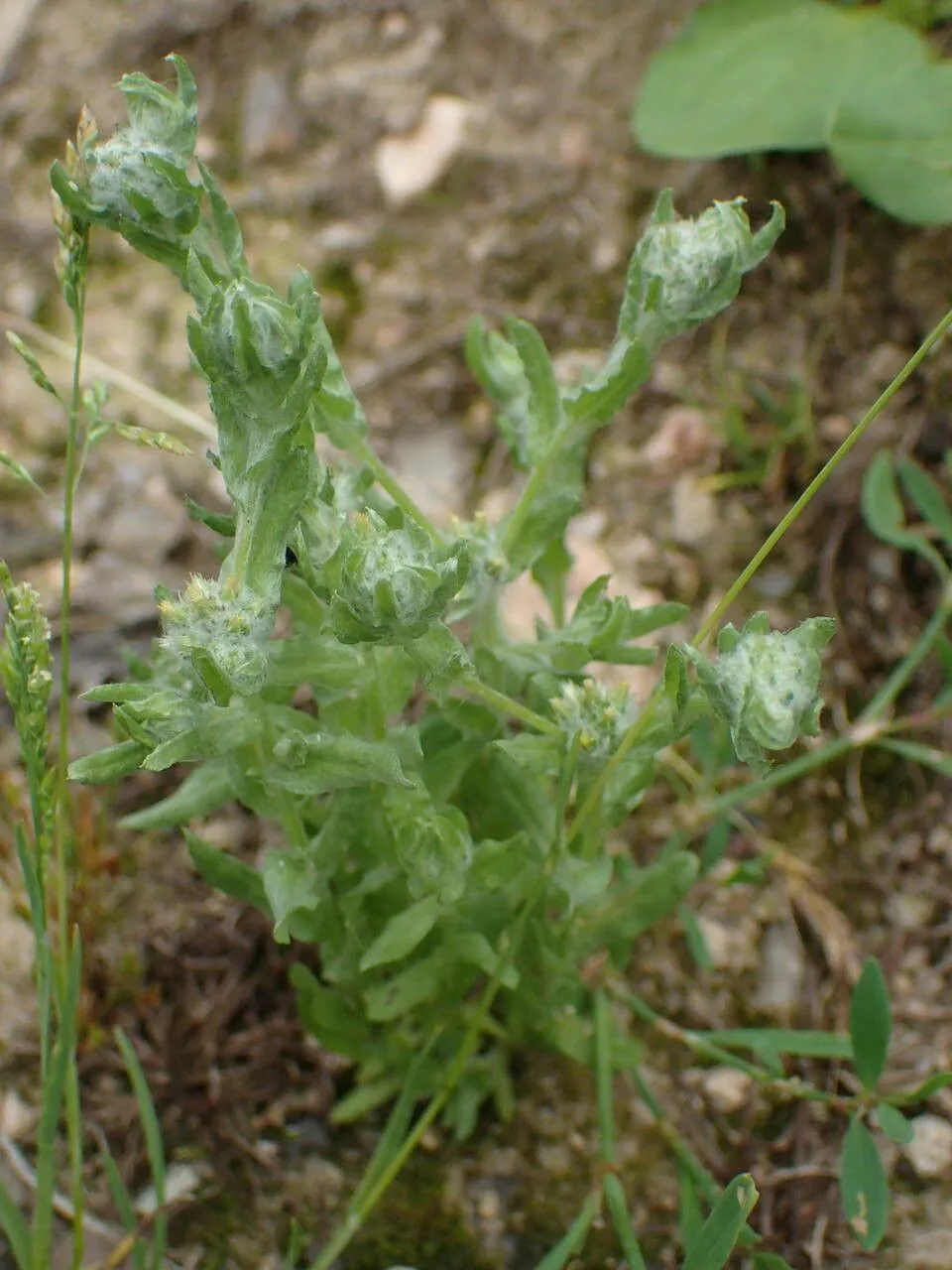
Author: L.
Bibliography: Sp. Pl.: 856 (1753)
Year: 1753
Status: accepted
Rank: species
Genus: Filago
Vegetable: False
Observations: Europe to W. Siberia and W. Himalaya, Canary Is., Morocco
Field cotton-rose, known scientifically as Filago arvensis, is a captivating member of the Asteraceae family. This plant species was first described in 1753, with its earliest documented description found in the authoritative work “Species Plantarum.”
Filago arvensis thrives across a diverse geographical range, extending from Europe to Western Siberia and the Western Himalayas. Noteworthy populations are also found in the Canary Islands and the North African region of Morocco. Its ability to adapt to these varied habitats underscores its resilience and versatility.
A characteristic feature of the Field cotton-rose is its delicate, cotton-like appearance, predominately visible when the plant is in bloom. The intricate structure of its flowers contributes a unique and subtle beauty to the landscapes it inhabits.
Ecologically, Filago arvensis plays a role in its ecosystem by providing habitat and food for various insects, including key pollinators. Its presence in different regions indicates the health and diversity of those ecosystems, reflecting its adaptability and ecological significance.
For botanists and plant enthusiasts, the Field cotton-rose represents an excellent subject of study due to its extensive range and adaptability. Its historical mention by notable botanist Carl Linnaeus adds a layer of botanical heritage, connecting the modern-day observer to centuries of botanical exploration and classification.
In summary, the Field cotton-rose is a remarkable specimen within the Asteraceae family, distinguished by its wide geographical distribution and ecological importance. It continues to intrigue botanists and nature enthusiasts alike, contributing to our understanding of plant diversity and adaptation.
Deu: acker-filzkraut, ackerfilzkraut
Dan: ager-museurt, almindelig hvene, dunet vejbred, engelskgræs
Swe: backtrift, mellantrift, rödkämpar, rödven, ullört, vanlig ullört
Nor: dunkjempe, engkvein
Fin: laukkaneilikka, nurmirölli, soikkoratamo
Nld: akkerviltkruid
Fra: cotonnière des champs
Eng: field cotton-rose, field cudweed, cudweed
En: Field cotton-rose, Field Cudweed, Least cudweed, Field cottonrose, Cudweed
Ar: قربط حقلي
Be: Калматка палявая
Ca: Herba cotonera
Zh: 絮菊
Cs: Bělolist rolní
Da: Ager-Museurt, Almindelig Hvene, Dunet Vejbred, Engelskgræs
Nl: Akkerviltkruid
Et: Põld-paganapea
Fi: Ketotuulenlento, Laukkaneilikka, Nurmirölli, Soikkoratamo
Fr: Cotonnière des champs, Gnaphale des champs, Immortelle des champs
De: Acker-Fadenkraut, Acker-Filzkraut, Acker-Ruhrkraut, Acker-Schimmelkraut, Ackerfilzkraut, Acker Filzkraut
It: Bambagia campestre, Logfia dei campi
Lt: Dirvinė pūkūnė
No: Dunkjempe, Engkvein
Pl: Nicennica polna
Ru: Жабник полевой
Sv: Ullört, Backtrift, Mellantrift, Rödkämpar, Rödven, Vanlig ullört
Tg: Дилошуб
Taken Jun 28, 2021 by inna (cc-by-sa)
Taken Jun 26, 2022 by m.claire fricheteau (cc-by-sa)
Taken Apr 29, 2021 by Zoé siegel (cc-by-sa)
Taken May 2, 2022 by Steven (cc-by-sa)
Taken Nov 23, 2017 by Tasha Kitz (cc-by-sa)
© copyright of the Board of Trustees of the Royal Botanic Gardens, Kew.
© copyright of the Board of Trustees of the Royal Botanic Gardens, Kew.
© copyright of the Board of Trustees of the Royal Botanic Gardens, Kew.
Taken Aug 10, 2014 by Tela Botanica − Jean-Claude CALAIS (cc-by-sa)
Taken Jul 7, 2009 by Tela Botanica − Mathieu MENAND (cc-by-sa)
Taken Jul 3, 2020 by Sylvain Piry (cc-by-sa)
Taken Jul 3, 2020 by Sylvain Piry (cc-by-sa)
Taken Jun 23, 2018 by Tonoli Luigia (cc-by-sa)
Taken Jul 20, 1853 by Tela Botanica − Herbier PONTARLIER-MARICHAL (cc-by-sa)
Taken Jul 4, 2010 by Tela Botanica − Marie PORTAS (cc-by-sa)
Taken Jul 15, 2014 by Photoflora – Benoit BOCK (©)
Taken Jan 1, 1800 by Tela Botanica − Daniel MATHIEU (cc-by-sa)
Taken Jul 3, 2020 by Sylvain Piry (cc-by-sa)
Taken Aug 6, 2018 by Tela Botanica − Philippe Provost (cc-by-sa)
Taken Aug 6, 2018 by Tela Botanica − Philippe Provost (cc-by-sa)
Taken May 11, 2016 by Tela Botanica − Françoise BOULANGER (cc-by-sa)
Taken May 2, 2022 by Steven (cc-by-sa)
Taken Jul 3, 2020 by Sylvain Piry (cc-by-sa)
Taken Jun 26, 2014 by Tela Botanica − Jean-Jacques HOUDRÉ (cc-by-sa)
Taken Jul 16, 2015 by Tela Botanica − Dominique REMAUD (cc-by-sa)
Taken Jul 7, 2009 by Tela Botanica − Mathieu MENAND (cc-by-sa)
Family: Myrtaceae Author: (F.Muell.) K.D.Hill & L.A.S.Johnson Bibliography: Telopea 6: 402 (1995) Year: 1995 Status:…
Family: Rubiaceae Author: Pierre ex A.Froehner Bibliography: Notizbl. Bot. Gart. Berlin-Dahlem 1: 237 (1897) Year:…
Family: Sapindaceae Author: Koidz. Bibliography: J. Coll. Sci. Imp. Univ. Tokyo 32(1): 38 (1911) Year:…
Family: Asteraceae Author: A.Gray Bibliography: Pacif. Railr. Rep.: 107 (1857) Year: 1857 Status: accepted Rank:…
Family: Fabaceae Author: Medik. Bibliography: Vorles. Churpfälz. Phys.-Ökon. Ges. 2: 398 (1787) Year: 1787 Status:…
Family: Aspleniaceae Author: (Cav.) Alston Bibliography: Bull. Misc. Inform. Kew 1932: 309 (1932) Year: 1932…